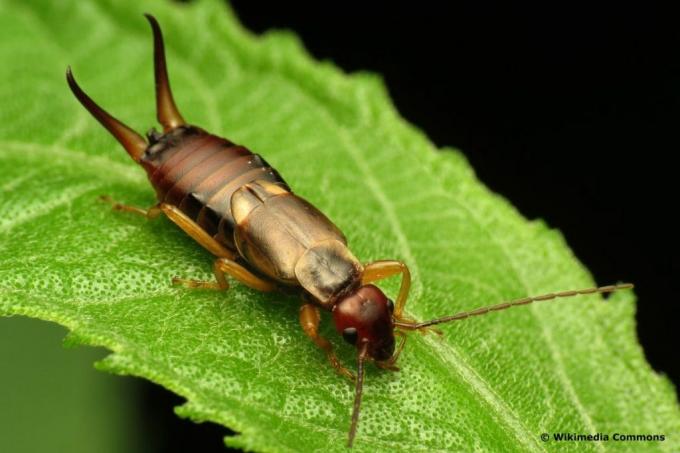
table of contents
- Occurrence of the ear creeper
- Wanted poster of the catchy tune
- Earwigs are omnivores
- Danger to people?
- Beneficial or pest?
- frequently asked Questions
Legend has it that the ear crawler crawls into people's ears at night, biting the eardrum to lay its eggs. Is that really true? You can get an answer here.
In a nutshell
- Ears are nocturnal
- they love warmth and moisture
- Earwigs are omnivores
- But ear hoofs are not dangerous
Occurrence of the ear creeper
The insects, which are universally known as catchy tunes, have many names. They are active at night and at dusk and catch prey here. They also have a preference for warmth and moisture. Seeing an ear crawler during the day is very rare. Usually such animals were startled. Ear crawlers are in

- Gardens and parks
- at forest edges and
- on balconies and terraces
At home. They are hardly to be found in the house or apartment, only stray animals. During the day they like to hide in dark places like:
- under leaf foliage
- under stones
- in cracks of bark
- in leaf sheaths of umbellate flowers or
- under flower pots on the balcony and terrace
Adult earwigs hibernate in the ground, but also under piles of leaves and brushwood, in hollow plant stems, as well as in abandoned bird nesting boxes.
Wanted poster of the catchy tune
The earwig (Dermaptera) is not a beetle, although they are related to them. Earwigs form an independent order of insects (Insecta). They belong to the flying insects (Pterygota). There are 30 different types in Europe. The common earwig (Forficula auricularia) is most common in Germany. Features are:

- Length 10-17 mm
- Females a little smaller
- Color reddish-yellowish brown to black
- yellowish legs
- tripartite body
- Head with sharp mouthparts, eyes and two antennae
- Winged chest section
- Depending on the type, either fully developed or regression to the point of unfit to fly
- prefer to go on foot
- Depending on gender, the abdomen is differently pronounced
- Forceps (cerci) present on the abdomen
- in male animals the pincers are strongly curved
- in females straight
Earwigs are omnivores
When it comes to their food, the panties are not picky about their food. Sometimes they also use fruit and vegetable plants, which is why they are often dismissed as pests. Their menu includes:
- Aphids and caterpillars
- Eggs from codling moths, mites and spider moths
- Powdery mildew and mushroom braids
- also animal droppings and carrion
- dead plant remains
- young vegetables, flowers and stamens
- Damaged buds and soft, slightly damaged fruit
Especially in dry years, they mainly feed on plants such as lettuce, strawberries or celery. In this way you can cover your existing water needs.
Note: The sand earwig (Labidura riparia) is a pure carnivore. It is very widespread mainly in the Baltic Sea.

Danger to people?
The earwigs are quickly considered dangerous because of their appearance. But the little "worm" can never be dangerous for humans. It only uses its threatening pincers and sharp mouthparts when hunting, to hold on to prey and to ward off enemies, as well as when mating to hold on to its partner. The legend that he crawls into ears and bites the eardrum there to lay his eggs is just a legend. The mouthparts are far too weak for that.
Beneficial or pest?
Some hobby gardeners see the ear hybrids as pests because they sometimes use crops. This is generally not true, it is a beneficial insect in the garden, because it is actively involved in the decomposition of biomass and can be used as a reliable pest controller. The animals not only exterminate annoying aphids and blood lice and other plant pests, but also remove harmful fungal plexuses, powdery mildew and dead plant parts. For these reasons, these animals should not be driven out of the garden, but rather attracted or relocated. A small “hotel” especially for the catchy tunes is ideal for this. You can build it yourself without much effort as follows:
- Fill the concrete flower pot with straw or wood wool
- either pull a net over it and knot it or
- Fasten wire mesh in front of the pot opening
- no straw should fall out
- To hang it up, pull a cord with a cross piece of wood through the pull-out hole beforehand
- Either hang the pot on a tree or put it in the garden
Tip: It should be posted near the wintering sites in early spring. The hotel can then go to its destination from mid-June.
frequently asked Questions
The name comes from the Middle Ages. Here the animals were ground to powder and used as a medicine in medicine for earache and also against deafness and hearing loss. The name has been handed down to this day.
If ear cancers should appear in the apartment, then it can only be a matter of stray animals. Fighting is not necessary. They should rather be put back into the open. A wet cloth in a corner of the room can be helpful for this. The animals withdraw there overnight and in the morning they can move outside without any problems.
First of all, all joints and cracks on windows and doors should be sealed with silicone. Furthermore, laundry that is dried outdoors should be shaken out well before being returned to the house. It is also advisable in autumn, before potted plants move to their winter quarters, to examine them carefully for the presence of small insects.



